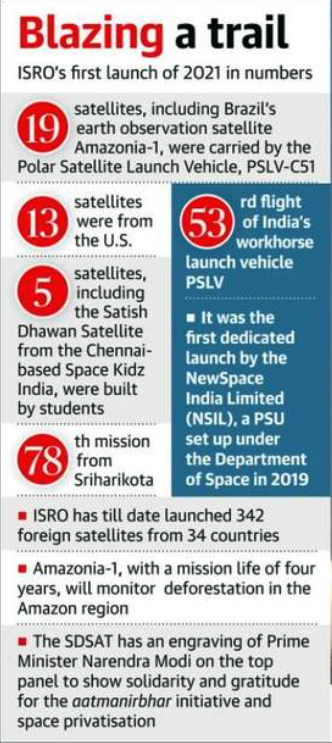Science & Technology
53rd PSLV Flight
- 02 Mar 2021
- 7 min read
Why in News
Recently, the 53rd flight of PSLV-C51 marked the first dedicated mission for New Space India Ltd (NSIL), the commercial arm of Indian Space Research Organisation (ISRO).
- In this flight, ISRO successfully launched Brazil’s optical earth observation satellite, Amazonia-1, and 18 co-passenger satellites from India (5) and the USA (13) from the Satish Dhawan Space Centre (SHAR) at Sriharikota.
- SHAR, Sriharikota is the Spaceport of India. It is responsible for providing Launch Base Infrastructure for the Indian Space Programme.
Key Points
- Brazilian Satellite Amazonia 1:
- About:
- Weighing 637 kg, belonging to the Brazilian National Institute for Space Research (INPE), was injected into its precise orbit of 758 km in a sun-synchronous polar orbit successfully.
- Objective:
- To strengthen the existing structure by providing remote sensing data to users for monitoring deforestation in the Amazon region and for analysis of diversified agriculture across the Brazilian territory.
- About:
- 5 Indian Satellites:
- UNITYsat (three satellites):
- They have been deployed to provide Radio relay services.
- UNITYsat was designed and built as a joint development by Jeppiaar Institute of Technology, Sriperumpudur (JITsat), G. H. Raisoni College of Engineering, Nagpur (GHRCEsat) and Sri Shakthi Institute of Engineering and Technology, Coimbatore (Sri Shakthi Sat).
- SDSAT:
- Satish Dhawan Satellite (SDSAT) is a nano satellite intended to study the radiation levels/space weather and demonstrate long range communication technologies.
- It was built by Chennai-based Space Kidz (an organization dedicated to designing innovative concepts for students in the field of education).
- SDSDAT also has an engraving of the Indian Prime Minister on the top panel of the satellite to show solidarity and gratitude for the Atmanirbhar initiative and space privatisation.
- A Bhagavad Gita was also sent on-board in an SD card to give the scripture, which teaches oneness as the highest form of humanity, the highest honour.
- SindhuNetra:
- It was developed by students of Bengaluru-based PES University, which was awarded the Rs. 2.2 crore contract by the Defence Research and Development Organisation (DRDO).
- This project will help in identifying suspicious ships through satellite imaging.
- UNITYsat (three satellites):
- USA Satellites:
- 13 satellites were from the USA, one was a technology demonstration satellite (SAI-1 Nano Connect 2) and the remaining for 2-way communications and data relay (SpaceBEEs).
- Significance:
- Provided Impetus to Indo-Brazil Relationship:
- Since the early 2000s, India and Brazil have signed cooperative instruments for exploration and peaceful uses of outer space, both at the government level (2004) and space agency level (between ISRO and Brazilian Space Agency AEB in 2002).
- The new satellite (Amazonia-1) would open the door for multiple business, trade and governmental opportunities. Brazil has also requested India's support in procurement of material and systems for its launch vehicle programme.
- Implemented New Space Reforms:
- Five Indian satellites were built under the new space reforms announced by the Government of India.
- The approved reforms will boost the private sector participation in the entire range of space activities.
- Four of the co-passenger satellites were signed for launch by IN-SPACe, ISRO’s small satellites facilitation agency, and 14 were signed up through NSIL for commercial launch.
- IN-SPACe: It is an independent nodal agency under the Department of Space (DOS) for allowing space activities and usage of DOS owned facilities by Non-Government private Entities (NGPEs) as well as to prioritise the launch manifest.
- NSIL: It is the commercial arm of Indian Space Research Organisation (ISRO) with the primary responsibility of enabling Indian industries to take up high technology space related activities. It is also responsible for promotion and commercial exploitation of the products and services emanating from the Indian space.
- Five Indian satellites were built under the new space reforms announced by the Government of India.
- Demonstrated Applications of Space Technology:
- Projects such as this demonstrate the extension of applications of Space Technology to different sectors and areas which brought ‘ease of living’, ‘ease of environment’ and ‘ease of humanity’ for common man.
- Provided Impetus to Indo-Brazil Relationship:
Polar Satellite Launch Vehicle
- About:
- Polar Satellite Launch Vehicle (PSLV) is the third generation launch vehicle of India.
- It is a four-staged launch vehicle with first and third stages using solid rocket motors and second and fourth stages using liquid rocket engines.
- It is the first Indian launch vehicle to be equipped with liquid stages.
- Capacity:
- Initially, PSLV had a carrying capacity of 850 kg but has been enhanced to 1.9 tonnes.
- Accomplishments:
- The PSLV has helped take payloads into almost all the orbits in space including Geo-Stationary Transfer Orbit (GTO), the Moon, Mars and would soon be launching a mission to the Sun.
- Between 1994 and 2019, the PSLV launched 50 Indian satellites and 222 foreign satellites for over 70 international customers from 20 countries.
- It has a history of successful launches of payloads that include Chandrayaan-1, Mars Orbiter Mission (MOM) and the space recovery mission, etc.
- The PSLV has failed only twice in its history — the maiden flight of the PSLV D1 in 1993 and the PSLV C-39 in 2017.






